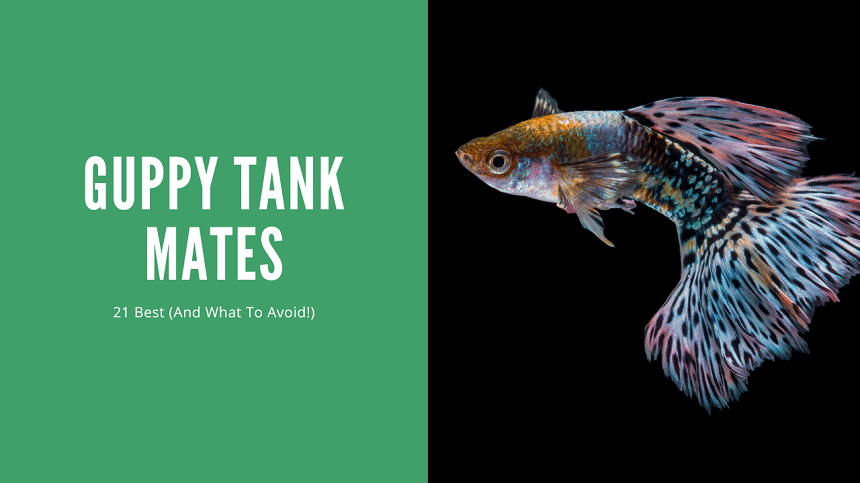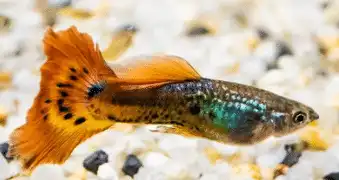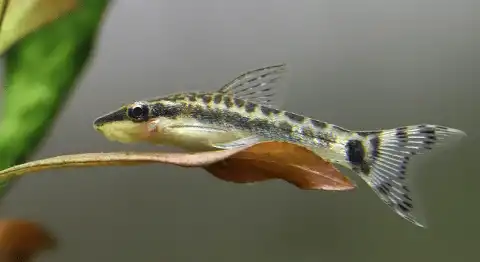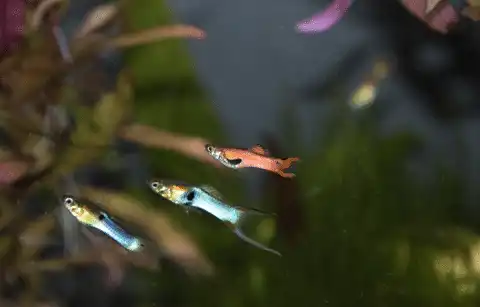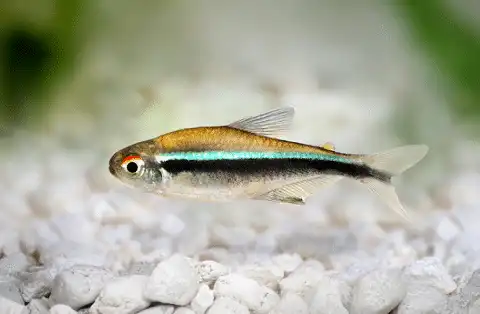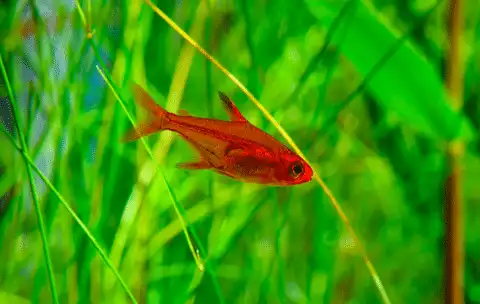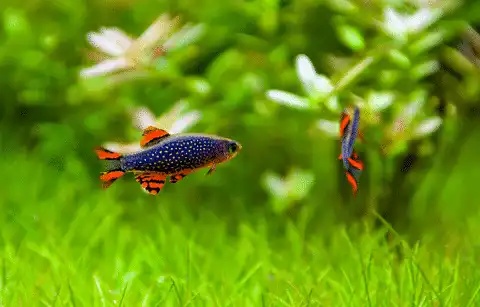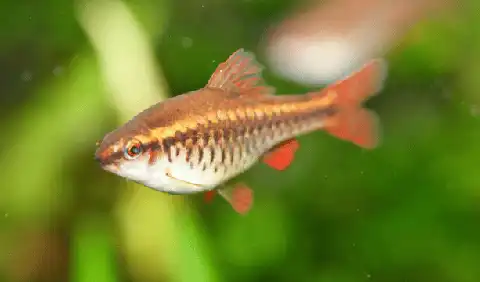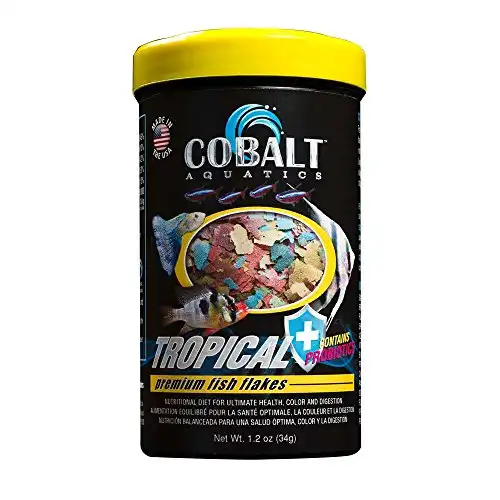Thank you for visiting! By the way… any links on this page that lead to products on Amazon and other stores/partners are affiliate links Aquarium Store Depot earns a commission if you make a purchase.
Are you looking to add more species to your guppy fish aquarium? Guppies are great in a species-only tank, but you can keep them with many other beautiful fish species too. If you would like to set up your own lively guppy community tank, this post is just for you!
Let’s get started!
Key Takeaways
- Choose similar-sized, slow-moving tank mates for your guppies
- Avoid large predatory fish or any species with a tendency to nip fins
- The best guppy tank mates are fish that enjoy the same water parameters
- Almost all freshwater fish will eat baby guppies. Use a separate breeding tank for your breeding projects
How To Choose Guppy Tank Mates
Choosing tank mates for guppies is not something you should rush into without careful thought. Sure, these livebearers are really easy-going and get along great with much other fish, but you really want to make sure everyone is comfortable in the same tank.
There are a few things to consider. Read along as we break these factors down and cover what you need to know when choosing guppy tank mates.
Water Parameters
What are water parameters? Well, the tropical fish we keep come from different parts of the world with different climates, geologies, and different environments in general. These factors affect their water, and many fish are specifically adapted to those conditions.
Guppies are pretty hardy fish, but if you want them to thrive, you’ll need to recreate their natural environment1. Here’s a list of their preferred water parameters and conditions:
- Water Temperature: 64 – 82 °F
- pH: 7 – 8.5
- Hardness: 8 – 12 dGH
- Water flow: Low
- Tank size: 10 gallons +
Guppies prefer relatively hard water with neutral to high pH. Of course, any tank mate you choose needs to be comfortable with all of the same water parameters.
Temperament
Different fish species have different personalities. Some of it comes down to the individual fish, but you can usually assume that certain types of fish are going to be peaceful and safe to keep with your guppies.
Guppies are relatively peaceful fish, and the males, in particular, swim slowly due to their long, soft fins. This makes them vulnerable to aggressive fish and fin nippers like tiger barbs.
Size
Guppies are small fish. Male guppies reach just 1.5 inches in length, meaning many of the larger freshwater aquarium fish could swallow them whole. The ideal guppy tank mates are smaller than about 3.5 inches and have small mouths.
Guppies are prolific breeders. The females produce live young, so it’s only a matter of time before you spot some tiny baby fish in your tank.
Most fish will eat guppy fry, including their own parents! However, there are a few good tank mate options if you’d like some of the babies to survive.
Best 21 Companions
Now that you know more about choosing good tank mates for your guppy aquarium let’s dive right in and get to know some of the best examples!
Take note of the following important information to help you choose the best tank mates for tank size and water conditions. We have a video from our YouTube Channel. Our blog goes over 21 while the youtube video channel goes over the first 10 on this post. Give us a subscribe if you like our videos!
Each species of fish will include the following stats:
- Scientific Name
- Adult Size
- pH
- Water Temperature
- Minimum Tank Size
- Safe With Guppy Fry?
- Recommended School Size
1. Other Types
An undemanding fish that is a livebearer. Many varieties available
Before we get started with other tank mates, take a moment to consider adding more guppies. These fish come in a wonderful array of different colors and fin types, and they all do great in the same conditions!
I wouldn’t recommend mixing fancy guppy strains if you plan on breeding specific types, but if you don’t mind mixing your breeds, why not pick up a variety of different guppies?
2. Octocinclus Catfish
A small algae-eating fish. Also great with freshwater shrimp.
- Scientific Name: Otocinclus spp.
- Adult Size: 2 inches
- pH: 6.8 – 7.5
- Water Temperature: 74-79 °F
- Minimum Tank Size: 10 gallons
- Safe With Guppy Fry?: Yes
- Recommended School Size: 2 +
Otocinclus catfish (or just otos) are one of the most peaceful fish in the aquarium hobby. These nano catfish stay small and only eat algae, so they are a safe choice for guppy breeders.
Otos can be kept in tanks as small as 10 gallons, but they can be tricky to feed in such a small space because they are prolific algae eaters and can run out of food. Supplement their diet with zucchini and algae wafers if necessary.
3. Cherry Shrimp
Great red color and very hardy. Cherry shrimp are the best beginner shrimp for shrimp tanks
- Scientific Name: Neocaridina denticulata sinensis
- Adult Size: 1 inch
- pH: 6.5 – 7
- Water Temperature: 60 – 80 °F
- Minimum Tank Size: 5 gallons
- Safe With Guppy Fry?: Yes
- Recommended School Size: Any
Freshwater shrimp are fascinating tank mates for guppies, and you don’t have to worry about them eating your fry. Some guppies will snack on small shrimp, so make sure you have plenty of plants and caves where they can hide. Fine-leaved plants like Java moss are ideal for this.
There are loads of different freshwater shrimp species and breeds, which come in beautiful colors too. If you’re just starting out with inverts, choose cheaper beginner breeds like cherry shrimp to see if they get along with your fish.
4. Pygmy Cory Catfish
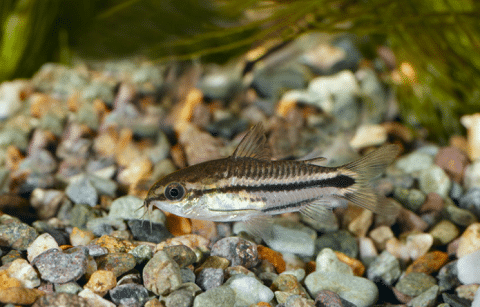
- Scientific Name: Corydoras pygmaeus
- Adult Size: 1.4 inches
- pH: 6.2 – 7.2
- Water Temperature: 72 – 79 °F
- Minimum Tank Size: 10 gallons
- Safe With Guppy Fry?: Possibly
- Recommended School Size: 6+
Pygmy cory catfish are excellent tank mates for guppies. These tiny schooling fish prefer to hang out in the mid-water levels of the tank, unlike their larger bottom-dwelling relatives.
Pygmy cory catfish are super peaceful, so they are usually a safe bet with shrimp, and they probably won’t snack on your guppy fry either.
There are many other species of cory catfish in the aquarium hobby, and most of them make great guppy tank mates. However, the larger species will work better in a tank of at least 30 gallons.
5. Kuhli Loach
Kuhli Loaches are hardy bottom-dwelling fish. Nocturnal in nature. Gets along with many fish and tolerate of coldwater environments
- Scientific Name: Pangio kuhlii
- Adult Size: 4 inches
- pH: 6 – 7
- Water Temperature: 77 – 82 °F
- Minimum Tank Size: 15 gallons
- Safe With Guppy Fry?: No
- Recommended School Size: 3+
Kuhli Loaches are excellent tank mates for guppies if you have water right around neutral on the scale. These strange, stripey eel-like fish are super entertaining to watch as they search the bottom of the tank for morsels.
These scaleless fish can be pretty shy because they are nocturnal, but you will love seeing them when they come out. Kuhli loaches are also very peaceful, so they won’t ever bother your guppies.
6. Swordtail Fish

- Scientific Name: Xiphophorus hellerii
- Adult Size: 5 – 6 inches
- pH: 7 – 8
- Water Temperature: 61 – 82 °F
- Minimum Tank Size: 20 gallons
- Safe With Guppy Fry?: No
- Recommended School Size: 5+
Swordtail fish are livebearers, just like your guppies. You’ll see the resemblance when you look at these fish, although swordtails actually grow a lot larger.
Male swordtails grow long, pointed tail fins which are where they get their name. Swordtails usually make great tankmates for guppies, but the males can sometimes get a little aggressive. I recommend having a backup plan in case things don’t work out between these two popular tropical fish species.
7. Endler’s Livebearers
A very active and colorful livebearer. Smaller in size than guppies
- Scientific Name: Poecilia wingei
- Adult Size: 1 – 1.8 inches
- pH: 7 – 8.5
- Water Temperature: 75 – 86 °F
- Minimum Tank Size: 10 gallons
- Safe With Guppy Fry?: No
- Recommended School Size: 4+
Endler’s are very similar to guppies and will get along perfectly. In fact, these fish are so closely related that they can breed together to create hybrids. The results are beautiful little fish, but I would not recommend mixing Endler’s and fancy guppies if you are planning on breeding your fish.
8. Platy Fish

- Scientific Name: Xiphophorus maculatus
- Adult Size: 2 – 3 inches
- pH: 7 – 8.2
- Water Temperature: 68 – 79 °F
- Minimum Tank Size: 15 gallons
- Safe With Guppy Fry?: No
- Recommended School Size: 5+
Platies are yet another awesome livebearer fish. These colorful fish grow just a little larger than guppies, but they enjoy the same water conditions, making them great guppy tank mates!
Platies come in many different color varieties, including gold wagtails, neon blues, and even black. Platy fish are easy to feed and easy to care for, so they are a great choice for beginners setting up a community tank.
9. Black Neon Tetra
A variant neon variety. More reliant than neon and cardinal tetras
- Scientific Name: Hyphessobrycon herbertaxelrodi
- Adult Size: 1.5 inches
- pH: 5 – 7.5
- Water Temperature: 68 – 82 °F
- Minimum Tank Size: 20 gallons
- Safe With Guppy Fry?: No
- Recommended School Size: 6+
The black neon tetra is a beautiful freshwater fish from South America. These peaceful schooling fish get along great with many other freshwater fish, including guppies!
These fish grow to a similar size and will thrive on the same diet. Just be sure to pick up a school of at least six black neons. You will love the way they swim together!
10. Ember Tetra
A small red tetra that grows up to 1.25 inches. A very peaceful schooling fish
- Scientific Name: Hyphessobrycon amandae
- Adult Size: 0.75 inches
- pH: 5 – 7
- Water Temperature: 68 – 82 °F
- Minimum Tank Size: 10 gallons
- Safe With Guppy Fry?: No
- Recommended School Size: 8+
Ember tetras are true nano fish and they make great tank mates for guppies. These golden orange fish have a very peaceful nature and they are the perfect choice for a heavily planted tank.
Ember tetras prefer slightly acidic to neutral water pH. They will work with guppies if you have a pH of about 7.
11. Chili Rasbora
Use Promo Code ASDFLIPPROMO
A great nano schooling fish. Males display brighter colors. Best in groups of 6 or more
- Scientific Name: Boraras brigittae
- Adult Size: 0.75 inches
- pH: 5 – 7
- Water Temperature: 68 – 82 °F
- Minimum Tank Size: 5 gallons
- Safe With Guppy Fry?: No
- Recommended School Size: 6+
Chili rasboras are tiny freshwater fish from Southeast Asia. These peaceful fish make great guppy tank mates.
Chili rasbora fish can be a little shy, which is understandable because they are so small. Keep them in a big school in a well-planted aquarium to really enjoy their beautiful colors and patterns.
12. Galaxy Rasbora (Celestial Pearl Danio)
A great-looking danio fish. Males are more colorful than females. A midway dwelling fish
- Scientific Name: Celestichthys margaritatus
- Adult Size: 0.75 inches
- pH: 6.5 – 7.5
- Water Temperature: 68 – 78 °F
- Minimum Tank Size: 10 gallons
- Safe With Guppy Fry?: No
- Recommended School Size: 5 +
Galaxy rasbora fish are a great species for your guppy fish tank. These peaceful freshwater fish stay really small at less than an inch, so you can comfortably keep a small school with some guppies in a 15-gallon aquarium.
Galaxy rasboras are also known as celestial pearl danios, and both names suit them well. They have bright orange fins, and the pearly spots on their sides look just like a starry night sky!
13. Harlequin Rasbora
A peaceful schooling fish. An ideal community fish. A great beginner fish
- Scientific Name: Trigonostigma heteromorpha
- Adult Size: 1.5 – 1.75 inches
- pH: 5 – 7.5
- Water Temperature: 70 – 82 °F
- Minimum Tank Size: 15 gallon
- Safe With Guppy Fry?: No
- Recommended School Size: 8+
Harlequin Rasbora fish are a go-to community fish in the aquarium hobby and one of my favorite guppy tank mates. These schooling fish have great colors and personalities and won’t fight with your guppies.
Harlequin Rasboras do best in fish tanks with plenty of live plants. They will definitely snack on your guppy fry if they can, so consider a separate breeding tank if you want your baby fish to grow out safely.
14. White Cloud Minnows
A very peaceful fish that does well in coldwater fish. Other minnow varieties are also available
- Scientific Name: Tanichthys albonubes
- Adult Size: 1.5 inches
- pH: 6 – 8.5
- Water Temperature: 57 – 71 °F
- Minimum Tank Size: 15 gallons
- Safe With Guppy Fry?: No
- Recommended School Size: 6 +
White cloud minnows are peaceful shoaling fish from China. These small fish have beautiful red fins and a neon stripe down their sides.
White cloud minnows make awesome guppy tank mates in lower water temperatures. These two freshwater aquarium fish can be kept together in water temperatures between about 66 and 70°F
15. Cherry Barbs
- Scientific Name: Puntius titteya
- Adult Size: 2 inches
- pH: 6 – 8
- Water Temperature: 74 – 79°F
- Minimum Tank Size: 15 gallons
- Safe With Guppy Fry?: No
- Recommended School Size: 6+
Cherry barbs are another peaceful species of small, schooling fish that you can keep with guppies. These fish usually thrive in the same water conditions as your guppies, and the two species won’t fight if you keep them in schools.
Cherry barbs are social fish and need to have a few of their own kind around to be comfortable. Pick up at least six of these beautiful reddish fish, but go for more if you have a big enough tank.
16. Honey Gourami
One of the more peaceful Gourami fish available in the hobby. Has a unique yellow coloration and only grows up to 2 inches in length
- Scientific Name: Trichogaster chuna
- Adult Size: 2 inches
- pH: 6 – 7.5
- Water Temperature: 72 – 80°F
- Minimum Tank Size: 15 gallons
- Safe With Guppy Fry?: No
- Recommended School Size: 1+
Honey gouramis are small, peaceful relatives of the betta fish. They can be kept on their own as a small centerpiece fish, but are more comfortable in a small group.
These colorful fish usually have a very peaceful nature, but you can expect males to become a little territorial during the breeding season. At this time they will develop a dark throat and belly that contrasts with their bright yellow or orange body color.
17. Peacock Gudgeon
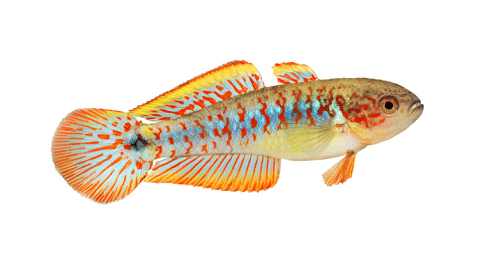
- Scientific Name: Tateurndina ocellicauda
- Adult Size: 3 inches
- pH: 6.5 – 7.5
- Water Temperature: 72 – 79°F
- Minimum Tank Size: 10 gallons
- Safe With Guppy Fry?: No
- Recommended School Size: 6 +
Peacock gudgeons are unique and colorful fish from Papua New Guinea. These peaceful carnivores will not harm your guppies, although they will snack on their fry.
Peacock gudgeons are easy to care for, and you can even breed them in your home aquarium. They will feel most at home in a tank with plenty of rocks, driftwood, caves, and live plants.
18. Bristlenose Pleco
The Bristlenose Pleco is a smaller Pleco that does a great job of eating algae. Peaceful and gets along with most fish
- Scientific Name: Ancistrus sp.
- Adult Size: 5 inches
- pH: 6.5 – 7.4
- Water Temperature: 72 – 82 °F
- Minimum Tank Size: 30 gallons
- Safe With Guppy Fry?: Yes
- Recommended School Size: 1
Like the otocinclus catfish, bristlenose plecos help to keep your tank clean because they are great algae eaters. These unique fish are hardy and easy to keep, so they are great for beginners. Plecos hang out at the bottom of the tank, and they need a small cave and plenty of driftwood to really thrive.
Bristlenose plecos are territorial fish, so keep just one in your guppy community tank to avoid any conflict. Fortunately, these fish won’t bother your guppies, and they are unlikely to eat your baby guppies.
19. Molly Fish

- Scientific Name: Poecilia sphenops / P. latipinna
- Adult Size: 4 – 6 inches
- pH: 7 – 8
- Water Temperature: 68 – 82 °F
- Minimum Tank Size: 30 gallons
- Safe With Guppy Fry?: No
- Recommended School Size: 4+
Molly fish are very similar to guppies in many ways, and they can live together in the same tank. However, mollies grow much larger than guppies, and they can sometimes be a little mean towards their smaller relatives.
You can certainly try mixing the two species in a 30-gallon or larger community setup. Maintaining excellent water quality and growing plenty of live plants will give you the best chance at success, but have a backup plan ready, just in case.
20. Female Betta

- Scientific Name: Betta splendens
- Adult Size: 2.5 inches
- pH: 6 – 8
- Water Temperature: 72 – 86 °F
- Minimum Tank Size: 5 gallons
- Safe With Guppy Fry?: No
- Recommended School Size: 1
Betta fish are extremely popular in the aquarium hobby, and many fish keepers wonder if they can live with guppies. However, there are no guarantees because each betta fish has their own personality.
A single female betta is your best chance at success. They may not be as colorful as the males, but they are still amazing fish and tend to be less aggressive. However, I still recommend having a backup plan, just in case your fish don’t get along.
21. Shell Dwelling Dwarf Cichlids

- Scientific Name: Neolamprologus multifasciatus
- Adult Size: 1.5 inches
- pH: 7.5 – 9
- Water Temperature: 75 – 81 °F
- Minimum Tank Size: 10 gallons
- Safe With Guppy Fry?: No
- Recommended School Size: 2+
Most Cichlids will not go well with guppies, but the African shell dwellers are an awesome exception. A few species are available in the hobby, but Multis (Neolamprologus multifasciatus) are usually the easiest to find.
These tiny fish have a fascinating lifestyle. They live in empty snail shells at the bottom of the tank.
Multis are not very aggressive fish, but they are pretty territorial around their shells, so you’ll find that your guppies tend to hang out at the top. However, shell-dwelling cichlids will eat baby guppies. In fact, guppy fish fry are a great food source for them!
Planning Your Community Aquarium
If you already have a healthy guppy tank set up, you might already have everything you need to start a guppy community with other freshwater species. If you’re starting a new tank, here’s what you’ll need:
- 10+ gallon tank with hood
- Filter, heater, lighting
- Gravel or sand substrate
- Driftwood, rocks, and decorations
- Live plants (optional)
- Water test kit and thermometer
- Gravel vacuum and algae scraper
- Water conditioner
Tank Size
You don’t need a large tank to set up an amazing guppy community aquarium. In fact, many of the fish in this list can be kept in a tank as small as 10 gallons!
However, there are limits to how many fish you can fit in a nano aquarium. I recommend starting with at least a 15-gallon setup if you want to mix two or more fish species.
Heating And Filtration
Guppies are tropical freshwater fish. You will need a heater to keep the water in its preferred range. Choose a heater that is designed to fit your fish tank size.
Filtration is essential for guppies and their tank mates. There are many different types to choose from, so choose a model that suits your needs. Guppies prefer a low water flow, so sponge filters are a great choice.
Look at a canister filter designed for your fish tank size for superior filtration. These filters produce little water flow while holding a large amount of filter media for biological and mechanical filtration.
Choosing Companions
You won’t be able to keep all the great tankmates in this post in the same tank, so how do you choose? One great way to plan a community tank is to think about where the different fish will hang out in your tank.
Bottom Dwellers
Different freshwater fish species swim at different levels in a fish tank. Try including some bottom dwellers to spread the movement in your guppy tank. Bottom dwellers are also great for cleaning up uneaten food from the bottom of the tank.
The following fish are great choices:
- Cory catfish
- Kuhli loach
- Bristlenose pleco
Schooling Fish
Guppies are not really schooling fish. They tend to spread out all over the tank when they feel comfortable. A group of schooling fish will make an awesome feature in your guppy community tank. The following species are ideal:
- Cherry barbs
- Black neon tetras
- Chili rasboras
- Neon Rainbowfish
Invertebrates
Invertebrates also make good tank mates for guppies. Consider adding the following species to your guppy tank for even more variety:
- Cherry shrimp
- Amano shrimp
- Nerite snails
Feeding Your Fish
You can feed your fish once or twice per day. Some fish keepers prefer to feed their fish three times per day; it all depends on your schedule. The important thing is to avoid overfeeding your fish.
Too much food can make your fish obese and unhealthy. However, the biggest risk is the accumulation of uneaten food in your aquarium. This leads to poor water quality and even ammonia spikes that can be deadly for your fish.
Feed your fish only as much food as they can finish in a minute or so. You might need to reduce this amount if you feed your fish more than once daily.
Ideally, each fish in the tank should get its fair share of food, and nothing should be left behind, so watch your fish to work out the ideal feeding schedule for your tank.
Best Tropical Fish Flake Food
Cobalt offers a premium level flake food with probiotics. A color enhancing formula that works great for all tropical fish
Flake food or micro-pellets are ideal for most schooling guppy tank mates, but supplement their diet with brine shrimp and other live or frozen foods from time to time. Bottom feeders like kuhli loaches and cory catfish will eat leftover food, but they should also be fed sinking foods for bottom feeders.
Water Quality And Tank Maintenance
Keeping your fish healthy and your tank looking great requires a little effort on your part. Set aside an hour every week or two for regular maintenance, and you will have a beautiful and healthy fish tank for many years!
Cycling
Cycle your fish tank before adding any fish. This involves setting up your fish tank and filter and allowing the nitrogen cycle to get started for a few weeks before adding your fish. You can skip this step if you already have a cycled tank with guppies.
Add new fish in small numbers over a few days or weeks. This will allow your tank to adjust and build stronger colonies of beneficial bacteria.
Testing
Test your water quality regularly to monitor the health of your aquarium. You should test your water before adding any fish to know your pH and water hardness levels.
You’ll also want to test for ammonia and nitrites when cycling your tank. A tank that reads zero parts ammonia and zero parts nitrite is cycled and ready to be stocked.
Nitrates build up in your water over time. They increase as the beneficial bacteria in your filter break down fish poop and uneaten food. Nitrates are not highly toxic, but you’ll want to keep their levels below about 20 parts per million by performing regular maintenance.
Water Changes
Change your water regularly depending on your water test results. You might need to do this once, twice, or four times per month, depending on the size of your tank, your filtration, and how many fish you keep.
Start by switching off your heater and filter. Remove the water from your tank with your gravel vacuum, taking care to suck up as much waste from the bottom of the tank as possible. Replace the old water with dechlorinated water of the same temperature as your aquarium. Lastly, don’t forget to switch your heater and filter back on!
Where To Buy
You will find many of the guppy tank mates in this post at your local fish store. However, some of the less common species, like shell-dwelling cichlids and peacock gudgeons, might be easier to find online. Only buy from trusted retailers that take great care of their livestock.
FAQs
Do Guppies Need Aquarium Salt?
Guppies are a freshwater species, so you do not need to add salt to their tank. Some aquarists add salt when their local water source is very soft, but this is not always unnecessary.
How Many Can You Have In A 10-Gallon Tank?
You can keep 5 to 10 adult guppies in a 10-gallon aquarium. The number will depend on the quality of your filtration and how much regular maintenance you do. Space is also an issue, so make sure there is plenty of swimming room.
Can They Live With Any Fish?
Guppies can live with many different freshwater fish. The best tank mates for guppies are similar in size and enjoy the same water parameters. Most small schooling fish that prefer neutral to alkaline water will make good tank mates. Avoid aggressive fish like tiger barbs and large fish like oscar fish that will eat your guppies.
How Many Should Be Kept Together?
The minimum number of guppies is three. However, stocking one male with three or four females is a better place to start because it spreads out his attention and reduces the stress on the females. You can keep no maximum number of guppies if you have a large enough aquarium.
Do They Need Other Fish?
Guppies do not need to live with other fish. In fact, a guppy-only tank is an awesome way to get started in the aquarium hobby and learn to breed your fish.
Final Thoughts
Guppies get along really well with many peaceful freshwater fish, but doing your research before pointing out your favorite fish to the salesperson in the shop is always the way to go. Use this guide to help you make an informed decision and choose some awesome new friends for your guppies!
Which is your favorite guppy fish tank mate? Let us know in the comments below!
- About the Author
- Latest Posts

Nicole Arroyo is our digital content editor for over 3 years. Nicole has a diverse background as a chief editor and in digital marketing for over 5 years.
Nicole is the media and video guru behind the scenes and is currently in charge of our video uploading and scheduling. Nicole makes sure the site not only looks good but is accurate.
You can reach her on LinkedIn.

